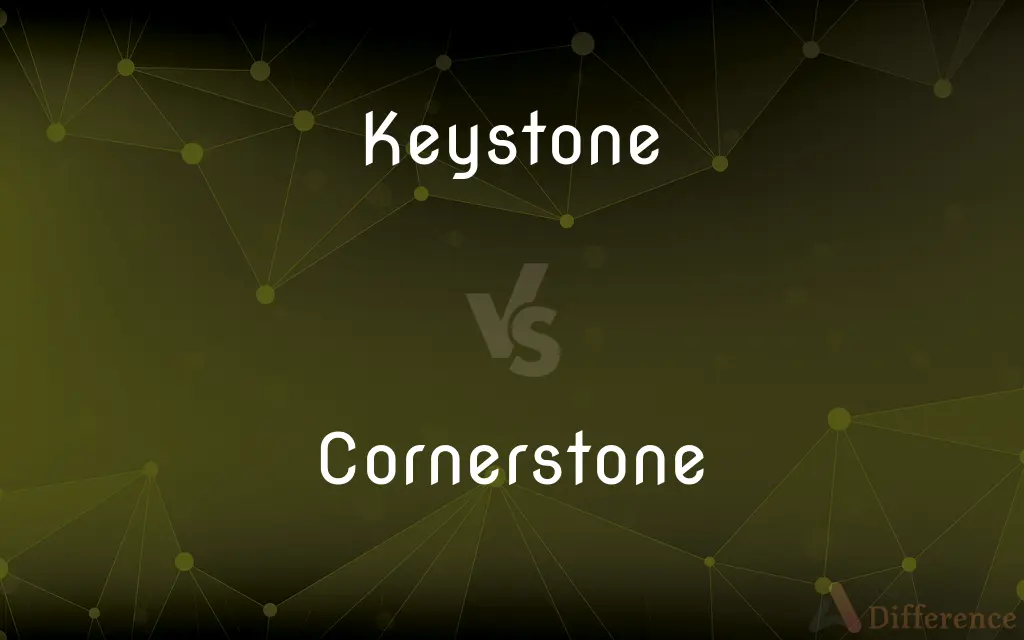Keystone vs. Cornerstone — What's the Difference?
By Maham Liaqat & Urooj Arif — Updated on March 8, 2024
A keystone is the central stone in an arch that locks its parts together, while a cornerstone is a foundational stone set at the corner of a building, symbolizing its starting point.

Difference Between Keystone and Cornerstone
Table of Contents
ADVERTISEMENT
Key Differences
The keystone, typically found at the apex of an arch, plays a critical structural role by bearing the weight of the other stones, allowing the arch to maintain its stability and distribute the load evenly. This stone is often larger or differently shaped compared to the other stones in the arch, designed to lock the structure into place once inserted. In contrast, the cornerstone is usually the first stone laid for a structure, often part of the foundation, and it can carry historical or ceremonial importance. It may be inscribed with the construction dates, builder names, or other significant information, serving as a time capsule or a symbolic gesture for the building's inception.
While the keystone is pivotal for the integrity of arches and vaults, contributing to the architectural strength and design of structures that utilize this element, the cornerstone is more about symbolizing the commencement and foundational significance of a building. It's less about physical support and more about its emblematic value.
In a broader metaphorical sense, "keystone" is used to describe the central supporting element of a system or concept that holds everything together, whereas "cornerstone" refers to the foundational basis upon which further development is built. For example, trust might be considered the keystone of a relationship, crucial for holding it together, while a cornerstone of democracy could be the principle of free speech, upon which the system is built.
Both terms have transcended their original architectural meanings and are frequently used in literature, speeches, and various forms of communication to convey the importance of a central or foundational element in abstract concepts, organizations, systems, or theories.
Comparison Chart
Definition
Central stone in an arch, locking the parts together.
Foundational stone at the corner of a building's foundation.
ADVERTISEMENT
Function
Provides structural integrity for arches and vaults.
Symbolizes the start and foundation of a building.
Placement
At the apex of an arch.
At a corner of the building's foundation.
Symbolism
Represents the critical supporting element that holds a structure or concept together.
Represents the foundation and inception of a structure or concept.
Metaphorical Use
Used to describe the central element that maintains the cohesion of a system.
Used to refer to the basic, foundational principles upon which something is built.
Compare with Definitions
Keystone
Central to the architecture of arches and vaults.
The ancient Roman aqueducts utilized keystones at the apex of each arch, showcasing their engineering prowess.
Cornerstone
Traditionally the first stone set in the construction of a masonry foundation.
The laying of the cornerstone marked the official beginning of the construction project.
Keystone
Often larger or distinctively shaped compared to other stones.
The keystone is easily identifiable by its larger size and wedge shape, distinguishing it from the other stones.
Cornerstone
Carries historical or ceremonial significance.
The cornerstone of the old courthouse was inscribed with the names of the founding city officials.
Keystone
Symbolizes the central supporting element in various contexts.
In the ecosystem, bees are considered a keystone species due to their critical role in pollination.
Cornerstone
Symbolizes the foundation upon which a building or concept is built.
Mutual respect and understanding are the cornerstones of a healthy partnership.
Keystone
Represents the cohesion and integrity of a system.
Free speech is often seen as the keystone of a free society, essential for maintaining democratic values.
Cornerstone
May contain inscriptions, time capsules, or other significant items.
During renovations, a time capsule was found within the building's cornerstone, containing artifacts from the era it was built.
Keystone
Bears the weight and locks the arch's structure.
Removing the keystone from an arch can cause the structure to collapse due to the loss of central support.
Cornerstone
Less about physical support and more about emblematic value.
The Bill of Rights can be considered the cornerstone of American constitutional law, embodying the nation's fundamental principles.
Keystone
(Architecture) A wedge-shaped stone at the top of an arch, often larger or more ornamented than the other voussoirs. Also called headstone.
Cornerstone
The cornerstone (or foundation stone or setting stone) is the first stone set in the construction of a masonry foundation. All other stones will be set in reference to this stone, thus determining the position of the entire structure.
Keystone
The central supporting element of a whole.
Cornerstone
An important quality or feature on which a particular thing depends or is based
A national minimum wage remained the cornerstone of policy
Keystone
(architecture) The top stone of an arch.
Cornerstone
A stone that forms the base of a corner of a building, joining two walls.
Keystone
Something on which other things depend for support.
Cornerstone
A stone at the corner of a building uniting two intersecting walls; a quoin.
Keystone
A native or resident of the American state of Pennsylvania.
Cornerstone
Such a stone when inscribed with the date of the start of the construction of the building.
Keystone
(retail) A retail price that is double the cost price; a markup of 100%.
Cornerstone
An indispensable and fundamental basis
The cornerstone of an argument.
Keystone
(baseball) The combination of the shortstop and second baseman.
Cornerstone
A stone forming the base at the corner of a building.
Keystone
(transitive) To distort (an image) by projecting it onto a surface at an angle, which for example causes a square to look like a trapezoid.
Cornerstone
Such a stone used ceremonially, often inscribed with the architect's and owner's names, dates and other details.
Keystone
To double the cost price in order to determine the retail price; to apply a markup of 100%.
Cornerstone
(figuratively) That which is prominent, fundamental, noteworthy, or central.
Keystone
The central or topmost stone of an arch. This in some styles is made different in size from the other voussoirs, or projects, or is decorated with carving. See Illust. of Arch.
Cornerstone
The fundamental assumptions from which something is begun or developed or calculated or explained;
The whole argument rested on a basis of conjecture
Keystone
A central cohesive source of support and stability;
Faith is his anchor
The keystone of campaign reform was the ban on soft money
He is the linchpin of this firm
Cornerstone
A stone in the exterior of a large and important building; usually carved with a date and laid with appropriate ceremonies
Keystone
The central building block at the top of an arch or vault
Cornerstone
A stone at the outer corner of two intersecting masonry walls
Common Curiosities
Is the keystone always placed at the top of an arch?
Yes, the keystone is typically positioned at the apex of an arch, serving as the central locking piece.
Can a building have more than one cornerstone?
Traditionally, a building has one cornerstone, but in a symbolic or ceremonial context, multiple stones may be referred to as cornerstones.
Do all buildings have a physical cornerstone?
Not all modern buildings have a distinct cornerstone as in traditional masonry; the term is often used symbolically in contemporary contexts.
Are cornerstones still used in building construction today?
While the practical use of cornerstones has diminished, they are still used ceremonially in significant buildings to mark historical or commemorative events.
What might be included in a cornerstone time capsule?
A time capsule in a cornerstone might contain documents, photographs, currency, or artifacts relevant to the building's era or purpose.
How is the cornerstone ceremony significant in modern times?
In modern times, the cornerstone ceremony serves as a symbolic event to commemorate the beginning of construction, often involving community leaders and capturing historical moments.
How do keystones contribute to the stability of an arch?
Keystones distribute the weight from the top of the arch down to the supports on either side, maintaining the integrity and stability of the arch.
How are keystones made to fit perfectly at the apex of an arch?
Keystones are carefully crafted, often with a slightly wider wedge shape, to snugly fit and lock the arch's structure when placed.
How do modern architects and builders interpret the roles of keystones and cornerstones?
In contemporary architecture, the roles of keystones and cornerstones are often more symbolic, reflecting heritage and tradition, rather than being essential structural elements.
Can the concept of a keystone be applied to fields outside of architecture?
Yes, the concept of a keystone is widely used metaphorically to describe a crucial element that holds a system or structure together, such as in ecology, business, or technology.
What happens if a keystone is removed from an arch?
Removing the keystone can compromise the structural integrity of an arch, potentially leading to its collapse, as the keystone is crucial for distributing and balancing the forces within the arch.
What is the historical importance of keystones and cornerstones in architecture?
Historically, keystones were essential for the construction of strong, stable arches, while cornerstones marked the foundational beginning of significant buildings, often with ceremonial significance.
What are the materials commonly used for keystones and cornerstones?
Keystones and cornerstones can be made from various durable materials, including stone, marble, and granite, often chosen for their symbolic or aesthetic qualities as well as their structural properties.
Can a structure have both a keystone and a cornerstone?
Yes, a structure that incorporates arches in its design could have both a keystone (for the arches) and a cornerstone (to symbolize its foundation).
Are there any famous buildings known for their keystones or cornerstones?
Many historic buildings and bridges are noted for their architectural use of keystones, while landmark buildings, such as the U.S. Capitol, are known for their ceremonially laid cornerstones.
Share Your Discovery

Previous Comparison
Urate vs. Urite
Next Comparison
Essential vs. NonessentialAuthor Spotlight
Written by
Maham LiaqatCo-written by
Urooj ArifUrooj is a skilled content writer at Ask Difference, known for her exceptional ability to simplify complex topics into engaging and informative content. With a passion for research and a flair for clear, concise writing, she consistently delivers articles that resonate with our diverse audience.














































